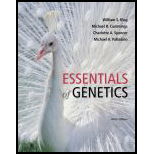
Essentials of Genetics (9th Edition) - Standalone book
9th Edition
ISBN: 9780134047799
Author: William S. Klug, Michael R. Cummings, Charlotte A. Spencer, Michael A. Palladino
Publisher: PEARSON
expand_more
expand_more
format_list_bulleted
Concept explainers
Question
Chapter 8, Problem 11PDQ
Summary Introduction
To review:
The temporal sequence of bacteriophage life-cycle.
Introduction:
The viruses that infect bacteria are known as bacteriophages. They serve as a very useful tool for genetic mapping and genetic modification of bacteria. This is due to a thorough understanding of their life cycle, which allows scientists to exploit the process in order to better understand bacterial genetics.
Expert Solution & Answer
Want to see the full answer?
Check out a sample textbook solution
Students have asked these similar questions
Describe the principle of homeostasis.
Explain how the hormones of the glands listed below travel around the body to target organs and tissues :
Pituitary gland
Hypothalamus
Thyroid
Parathyroid
Adrenal
Pineal
Pancreas(islets of langerhans)
Gonads (testes and ovaries)
Placenta
What are the functions of the hormones produced in the glands listed below:
Pituitary gland
Hypothalamus
Thyroid
Parathyroid
Adrenal
Pineal
Pancreas(islets of langerhans)
Gonads (testes and ovaries)
Placenta
Chapter 8 Solutions
Essentials of Genetics (9th Edition) - Standalone book
Ch. 8 -
CASE STUDY | To treat or not to treat
A...Ch. 8 - CASE STUDY | To treat or not to treat A...Ch. 8 - Prob. 3CSCh. 8 - Prob. 4CSCh. 8 - HOW DO WE KNOW? In this chapter, we have focused...Ch. 8 -
CONCEPT QUESTION
2. Review the Chapter Concepts...Ch. 8 -
3. Distinguish among the three modes of...Ch. 8 - With respect to F+ and F- bacterial matings, (a)...Ch. 8 - List all of the differences between F+ × F– and...Ch. 8 - Describe the basis for chromosome mapping in the...
Ch. 8 - Why are the recombinants produced from an Hfr × F–...Ch. 8 - Describe the origin of F' bacteria and...Ch. 8 -
9. Describe the mechanism of transformation.
Ch. 8 - .
10. The bacteriophage genome consists primarily...Ch. 8 - Prob. 11PDQCh. 8 - In the plaque assay, what is the precise origin of...Ch. 8 -
13. In the plaque assay, exactly what makes up a...Ch. 8 - A plaque assay is performed beginning with 1.0 mL...Ch. 8 -
15. Describe the difference between the lytic...Ch. 8 - Prob. 16PDQCh. 8 -
17. Explain the observations that led Zinder and...Ch. 8 -
18. Describe the execution of and rationale...Ch. 8 - If a single bacteriophage infects one E. coli cell...Ch. 8 - A phage-infected bacterial culture was subjected...
Knowledge Booster
Learn more about
Need a deep-dive on the concept behind this application? Look no further. Learn more about this topic, biology and related others by exploring similar questions and additional content below.Similar questions
- Describe the hormones produced in the glands listed below: Pituitary gland Hypothalamus Thyroid Parathyroid Adrenal Pineal Pancreas(islets of langerhans) Gonads (testes and ovaries) Placentaarrow_forwardPlease help me calculate drug dosage from the following information: Patient weight: 35 pounds, so 15.9 kilograms (got this by dividing 35 pounds by 2.2 kilograms) Drug dose: 0.05mg/kg Drug concentration: 2mg/mLarrow_forwardA 25-year-old woman presents to the emergency department with a 2-day history of fever, chills, severe headache, and confusion. She recently returned from a trip to sub-Saharan Africa, where she did not take malaria prophylaxis. On examination, she is febrile (39.8°C/103.6°F) and hypotensive. Laboratory studies reveal hemoglobin of 8.0 g/dL, platelet count of 50,000/μL, and evidence of hemoglobinuria. A peripheral blood smear shows ring forms and banana-shaped gametocytes. Which of the following Plasmodium species is most likely responsible for her severe symptoms? A. Plasmodium vivax B. Plasmodium ovale C. Plasmodium malariae D. Plasmodium falciparumarrow_forward
- please fill in missing parts , thank youarrow_forwardplease draw in the answers, thank youarrow_forwarda. On this first grid, assume that the DNA and RNA templates are read left to right. DNA DNA mRNA codon tRNA anticodon polypeptide _strand strand C с A T G A U G C A TRP b. Now do this AGAIN assuming that the DNA and RNA templates are read right to left. DNA DNA strand strand C mRNA codon tRNA anticodon polypeptide 0 A T G A U G с A TRParrow_forward
arrow_back_ios
SEE MORE QUESTIONS
arrow_forward_ios
Recommended textbooks for you
 Concepts of BiologyBiologyISBN:9781938168116Author:Samantha Fowler, Rebecca Roush, James WisePublisher:OpenStax College
Concepts of BiologyBiologyISBN:9781938168116Author:Samantha Fowler, Rebecca Roush, James WisePublisher:OpenStax College
 Human Heredity: Principles and Issues (MindTap Co...BiologyISBN:9781305251052Author:Michael CummingsPublisher:Cengage Learning
Human Heredity: Principles and Issues (MindTap Co...BiologyISBN:9781305251052Author:Michael CummingsPublisher:Cengage Learning Human Biology (MindTap Course List)BiologyISBN:9781305112100Author:Cecie Starr, Beverly McMillanPublisher:Cengage Learning
Human Biology (MindTap Course List)BiologyISBN:9781305112100Author:Cecie Starr, Beverly McMillanPublisher:Cengage Learning Biology: The Dynamic Science (MindTap Course List)BiologyISBN:9781305389892Author:Peter J. Russell, Paul E. Hertz, Beverly McMillanPublisher:Cengage Learning
Biology: The Dynamic Science (MindTap Course List)BiologyISBN:9781305389892Author:Peter J. Russell, Paul E. Hertz, Beverly McMillanPublisher:Cengage Learning Biology 2eBiologyISBN:9781947172517Author:Matthew Douglas, Jung Choi, Mary Ann ClarkPublisher:OpenStax
Biology 2eBiologyISBN:9781947172517Author:Matthew Douglas, Jung Choi, Mary Ann ClarkPublisher:OpenStax

Concepts of Biology
Biology
ISBN:9781938168116
Author:Samantha Fowler, Rebecca Roush, James Wise
Publisher:OpenStax College


Human Heredity: Principles and Issues (MindTap Co...
Biology
ISBN:9781305251052
Author:Michael Cummings
Publisher:Cengage Learning

Human Biology (MindTap Course List)
Biology
ISBN:9781305112100
Author:Cecie Starr, Beverly McMillan
Publisher:Cengage Learning

Biology: The Dynamic Science (MindTap Course List)
Biology
ISBN:9781305389892
Author:Peter J. Russell, Paul E. Hertz, Beverly McMillan
Publisher:Cengage Learning

Biology 2e
Biology
ISBN:9781947172517
Author:Matthew Douglas, Jung Choi, Mary Ann Clark
Publisher:OpenStax